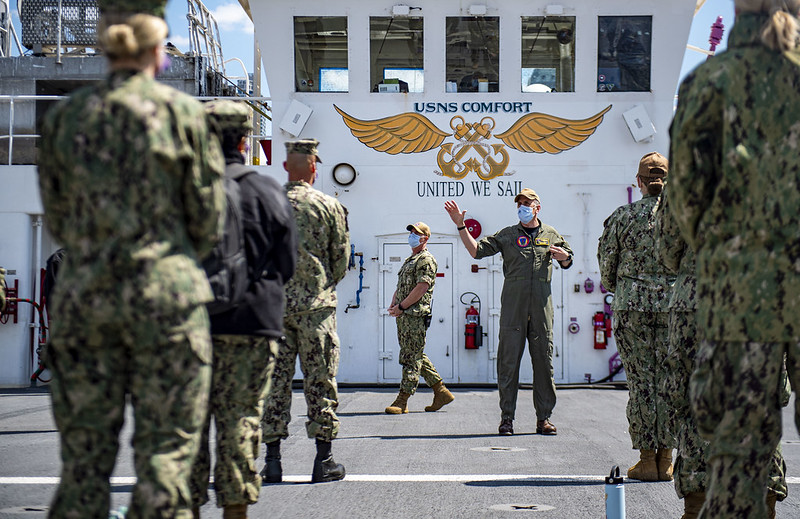
Managing Infectious Diseases During Deployment
American troops face many unorthodox threats while deployed, and COVID-19 is one such threat. From Italy to South Korea, at home and on the high seas, U.S. servicemembers are increasingly falling ill even as bases in particularly impacted areas have been evacuated or quarantined.
COVID-19 is the most pressing health threat, but infectious diseases have threatened U.S. troops abroad for virtually all of American history. The current focus on COVID-19 is an opportunity re-examine the ways infectious diseases threaten the military and what policies are in place to protect U.S. servicemembers from infections.
The Future of Infectious Disease
Deployed forces are exceptionally susceptible to infectious diseases. They are often deployed to developing nations where disease control is difficult, and they work under stressful conditions in close quarters. Deployments potentially put U.S. servicemembers in close contact with infected locals, disease vectors, and unsanitary conditions, exposing them to infectious diseases that could harm them. Saving lives requires understanding how and where the next infectious disease threat might come from.
Climate change will expedite the spread of infectious diseases. Global warming of 1.5-2°C may increase the geographic range of biting insects, exposing tens of thousands of servicemembers to insect-borne infections. The range of biting insects is growing most rapidly in Europe and South Asia, where at least 56 U.S. military installations may be exposed to diseases that are new to the region. In places where biting insects are already spreading disease, like northern Africa and the Middle East, warmer year-round temperatures would allow them to reproduce during months when they otherwise wouldn’t.
Climate change will also increase the frequency of extreme weather events, particularly in regions that are hot spots for infectious diseases. Warmer and wetter climates in densely populated developing nations create ideal conditions for spreading disease after a disaster. In the aftermath, American servicemembers will be sent to deliver humanitarian assistance, potentially exposing them to infectious diseases through close contact with local populations, unsanitary conditions, and biting insects.
An overlooked threat is the evolution of antibiotic resistance. U.S. troops are frequently prescribed antibiotics to prevent or treat infections, but they often stop taking their medication when they feel better and miss doses. When that happens, pathogens have a chance to develop resistances to common antibiotic drugs. Doctors are running out of options for treating drug-resistant strains of common bacterial infections. Antibiotic resistance is on the path to becoming a “serious and frightening” threat to U.S. armed forces.
Preventive measures
The first line of defense against the spread of infectious diseases is prevention. The Department of Defense (DoD) has developed protocols to limit infections among U.S. servicemembers. These protocols work well in theory but see mixed success in practice.
Troops deployed abroad generally receive a full regimen of vaccinations tailored to the region they’re visiting. For some widespread diseases that don’t have a vaccination, like Malaria, chemoprophylactic drugs are administered as a precaution. Vaccinations and chemoprophylactics are the most effective tools available for preventing infectious diseases. However, they often come with negative side effects. Until 2009, the U.S. military relied on a chemoprophylactic – Mefloquine – to protect troops from Malaria. Recent research into Mefloquine has revealed that prolonged exposure to the drug is linked to debilitating permanent brain damage.
In addition to biological preventive measures, servicemembers are given mosquito nets, bug-spray, and bite-resistant clothing when they’re deployed to areas where insect-borne illnesses are present. When used properly and supplemented by following other DoD advice, such as avoiding drinking from potentially contaminated local water sources, infections are exceedingly rare.
Unfortunately, preventative measures are imperfect. Personnel often fail to adhere to DoD infectious disease control guidelines. Despite shortcomings, DoD policies and modern medicine have resulted in historically low infection rates among U.S. armed forces. COVID-19, however, has revealed gaps in those infectious disease prevention policies that desperately need to be addressed.
Lasting Protections
COVID-19 isn’t all that different from other infectious diseases the U.S. military is used to dealing with. However, the rapid spread of the coronavirus caught the Pentagon off guard. To be better prepared for next time, the U.S. military should take this opportunity to reassess how it will handle future pandemics.
Another infectious disease outbreak will occur in the future. Ensuring the U.S. military can continue to be an effective fighting force means preparing for this eventuality with effective long-term disease prevention policies.






